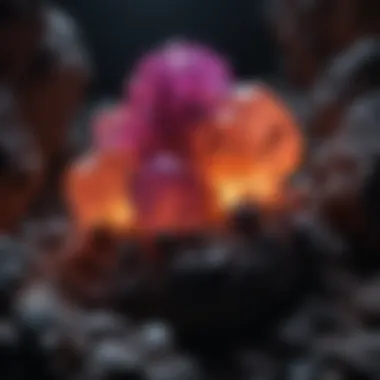Unveiling the Beauty of Fluorescent Minerals with Black Light Exploration


Rock and Fossil Identification
Delving into the world of fluorescent minerals through the lens of black light opens up a realm of hidden beauty awaiting discovery by avid rock and fossil collectors. Understanding the significance of identifying various types of rocks and fossils is paramount in appreciating the uniqueness that fluorescence can unveil. When exploring under black light, collectors should look for specific characteristics such as color intensity and patterns that indicate fluorescence. Utilizing tools like magnifying glasses and UV lights enhances the identification process, allowing collectors to distinguish between ordinary specimens and those with exceptional fluorescence potential.
Introduction to Fluorescent Minerals
The significance of understanding fluorescent minerals lies in the sheer wonderment that these specimens offer. Unlike traditional minerals, fluorescent minerals possess the captivating ability to emit vibrant colors when exposed to ultraviolet light, showcasing a mesmerizing spectacle that goes beyond the ordinary visual appeal. By grasping the nuances of fluorescence, collectors can gain a deeper appreciation for the geological processes that imbue these minerals with their distinct characteristics.
Moreover, exploring fluorescent minerals opens up a realm of possibilities for collectors to expand their knowledge and enhance their collection experience. By adding fluorescent minerals to their repertoire, collectors add a dynamic dimension to their displays, creating visually striking presentations that exemplify the beauty and diversity of the natural world. Through this section, rock and fossil enthusiasts are guided towards a newfound appreciation for fluorescent minerals, elevating their passion for geological treasures to a whole new level.
What Are Fluorescent Minerals?
Understanding Fluorescence in Minerals
The Science Behind Fluorescence
In the realm of fluorescent minerals, understanding the science behind fluorescence is paramount in unlocking the hidden beauty that lies within these mesmerizing specimens. Delving deeper into the molecular and atomic structures of minerals provides invaluable insight into how they interact with light, exemplifying the intricate processes that occur at a microscopic level. By comprehending the underlying principles of fluorescence, rock and fossil collectors can not only appreciate the aesthetic allure of these minerals but also enhance their collection experience through a deeper connection with the geological wonders.
Molecular Structure and Light Interaction
Molecular structure plays a pivotal role in determining a mineral's fluorescence properties. The arrangement of atoms within a crystal lattice influences how incoming light energy is absorbed and subsequently re-emitted as visible light. When illuminated by ultraviolet light, electrons within the mineral's structure absorb energy and jump to higher energy levels before releasing this energy as fluorescence. Therefore, the specific crystal structure dictates the wavelengths of light emitted, resulting in the vibrant colors exhibited by fluorescent minerals. Understanding this intricate dance between molecular architecture and light interaction unveils the magic behind fluorescence.
Key Factors Influencing Fluorescence
Several key factors influence the fluorescence exhibited by minerals, shedding light on the nuanced complexities that govern this phenomenon. The presence of certain impurities or rare earth elements can significantly enhance or diminish a mineral's fluorescence properties. Additionally, factors such as crystal defects, size, and orientation impact the efficiency of light absorption and emission, ultimately shaping the intensity and brilliance of fluorescence. By considering these factors, collectors can strategically curate their mineral specimens to highlight and maximize the captivating fluorescence, creating a visually stunning display that showcases the unique beauty of each specimen.


Choosing the Right Black Light for Mineral Collection
Selecting the ideal black light for mineral collection necessitates careful consideration of several factors to optimize the fluorescence detection experience. Firstly, collectors must assess the wavelength range of a black light, ensuring compatibility with the fluorescent properties of their mineral specimens. Different minerals exhibit unique fluorescence responses to specific UV wavelengths, underscoring the importance of selecting a light source that aligns with the desired outcomes.
Moreover, the intensity of UV radiation emitted by a black light warrants attention, as it directly impacts the visibility and saturation of fluorescent colors in minerals. Collectors may need to adjust the intensity levels based on the sensitivity of their specimens to UV light, fine-tuning the illumination to achieve the optimal fluorescence effect.
Additionally, considerations related to the size, weight, and power source of a black light are crucial for practicality and usability during mineral exploration. Collectors seeking prolonged use may prefer rechargeable black lights, while others focused on precision may opt for adjustable wavelength settings to suit different mineral types.
Ultimately, the selection of the right black light for mineral collection is a personalized decision influenced by each collector's unique preferences and priorities. By evaluating the specific needs and characteristics of their mineral specimens, collectors can enhance their exploration of fluorescence and uncover the hidden beauty within their collections.
Utilizing Black Light in Mineral Identification
In the realm of exploring fluorescent minerals, the utilization of black light in mineral identification stands as a pivotal technique for enthusiasts and collectors. By incorporating black light into the identification process, rock and fossil collectors can unveil the hidden fluorescence that these minerals possess, thereby enhancing the overall appreciation and understanding of their collections. The essence of utilizing black light lies in its ability to reveal unique fluorescence patterns that are otherwise invisible to the naked eye. This crucial step opens doors to a deeper exploration of the intricate world of fluorescent minerals, allowing collectors to distinguish between various mineral types based on their distinct fluorescence responses under black light.
Black light serves as a powerful tool for mineral identification due to its capability to excite specific minerals, causing them to emit characteristic fluorescent light. This process enables collectors to differentiate between minerals that may appear similar under normal lighting conditions but exhibit vibrant fluorescence disparities when exposed to black light. By utilizing black light, collectors can spot subtle variations in fluorescence intensity, color, and patterns, aiding in the accurate identification and classification of fluorescent minerals in their collection. Understanding the nuances of fluorescence patterns under black light not only adds a new dimension to the collection experience but also contributes to the scientific study and appreciation of these unique geological specimens.
Spotting Fluorescence Patterns in Minerals
Spotting fluorescence patterns in minerals under black light is an art that demands keen observation and attention to detail. As collectors venture into the realm of fluorescent minerals, the ability to detect and interpret fluorescence patterns plays a crucial role in identifying and appreciating the diversity of mineral specimens. When exposed to black light, different minerals exhibit distinct fluorescence patterns, ranging from simple glowing to intricate color variations and phosphorescent effects.
To spot fluorescence patterns effectively, collectors should observe the minerals in a darkened environment illuminated solely by black light. This practice enables the fluorescence emitted by the minerals to stand out prominently, facilitating the identification of unique patterns and colors. By honing their skills in spotting fluorescence patterns, collectors can develop a keen eye for details, allowing them to differentiate between minerals based on their specific fluorescence characteristics. This skill not only enhances the thrill of discovery but also adds value to the overall collection by showcasing the diverse array of fluorescent minerals and their distinctive features.
Enhancing Collection Display with Black Light
Integrating black light into collection displays elevates the visual appeal and educational value of fluorescent mineral exhibits. Displaying fluorescent minerals under black light transforms ordinary collections into mesmerizing showcases of glowing wonders, captivating viewers with the striking fluorescence emitted by these unique geological specimens. From vibrant reds to deep blues and bright greens, the use of black light accentuates the natural beauty of fluorescent minerals, creating a captivating display that mesmerizes and educates observers.
Enhancing collection displays with black light not only highlights the inherent fluorescence of minerals but also provides insights into their geological significance and chemical composition. By incorporating black light as a central element in collection displays, collectors can engage audiences in a sensory exploration of fluorescence, shedding light on the hidden beauty and scientific intrigue of fluorescent minerals. This immersive experience not only enriches the viewing pleasure of enthusiasts but also fosters a deeper appreciation for the beauty and diversity of fluorescent minerals in the natural world.


Safety Precautions and Best Practices
In the realm of exploring fluorescent minerals with the aid of black light, prioritizing safety precautions and best practices is paramount to ensure a rewarding and secure experience for rock and fossil collectors. By adhering to established safety guidelines, enthusiasts can indulge in their hobby responsibly while safeguarding themselves against potential hazards that may arise.
One of the primary aspects of safety precautions involves protecting oneself from any adverse effects of prolonged exposure to black light. This includes shielding the eyes and skin from the potentially harmful ultraviolet (UV) radiation emitted by the black light source.
Implementing eyewear that is specifically designed to block UV rays, such as UV-filtering goggles, is essential to shield the eyes from the intense light produced by the black light. Similarly, wearing protective clothing that covers exposed skin can help prevent UV radiation from causing skin irritation or harm.
Furthermore, understanding the proper handling and operation of black light equipment is crucial for maintaining a safe environment during mineral exploration. Inspecting the condition of the black light regularly and following manufacturer's guidelines for usage and maintenance can mitigate risks associated with equipment malfunction or damage.
By abiding by safety protocols and incorporating best practices into the mineral-collecting routine, rock and fossil enthusiasts can elevate their exploration experience while prioritizing their well-being.
Protecting Your Eyes and Skin
When delving into the world of fluorescent minerals under black light, safeguarding your eyes and skin from potential UV exposure is of utmost importance. The eyes, in particular, are sensitive to UV radiation and can be susceptible to damage if not adequately protected.
Investing in UV-filtering goggles or glasses designed for black light usage is crucial to shield your eyes from the intense UV light emitted by the black light source. These specialized eyewear options can help prevent eye strain, discomfort, and potential long-term damage caused by UV radiation.
In addition to eye protection, ensuring that exposed skin is covered while working with black light can reduce the risk of UV-induced skin irritation or burns. Wearing long sleeves, pants, and gloves made of UV-protective fabrics can provide an added layer of defense against UV exposure.
Regularly checking the UV protection levels of your eyewear and replacing them as needed, along with applying sunscreen to exposed skin, are simple yet effective measures to safeguard yourself while enjoying the mesmerizing fluorescence of minerals.
Cleaning and Maintenance of Black Light Equipment
Maintaining the functionality and longevity of black light equipment is vital for optimal performance when revealing the hidden fluorescence of minerals. Proper cleaning and upkeep procedures not only ensure the effectiveness of the black light but also contribute to a safer and more productive collecting environment.


Regularly cleaning the lenses and bulbs of the black light apparatus with a soft, lint-free cloth can prevent dust buildup and maintain the clarity of the emitted UV light. Avoiding harsh chemicals or abrasive cleaners is crucial to protect the integrity of the equipment's components.
Inspecting the wiring and connections of the black light for any signs of wear or damage is essential for preventing potential hazards such as electric shocks or malfunctions. Following the manufacturer's maintenance recommendations, including scheduled bulb replacements and equipment checks, can prolong the lifespan of the black light and ensure consistent performance.
By incorporating routine cleaning and maintenance practices into the care regimen of black light equipment, rock and fossil collectors can prolong the lifespan of their tools and continue to explore the captivating world of fluorescence with confidence and safety.
Exploring Fluorescent Mineral Specimens
In the realm of rock and fossil collecting, exploring fluorescent mineral specimens holds a significant allure and importance. This section not only adds a captivating dimension to collectors' pursuits but also provides a deeper understanding of the science and beauty intertwined in these mineral formations. By immersing oneself in the exploration of fluorescent mineral specimens, rock and fossil collectors can unearth a whole new world of vibrant hues and mesmerizing reactions under black light.
Exploring fluorescent mineral specimens offers a range of benefits to enthusiasts. It allows collectors to appreciate the intricate details and unique characteristics that are only revealed under specific lighting conditions. Furthermore, it brings a sense of discovery and wonder, as each mineral specimen unveils its hidden fluorescence, creating a visual spectacle that is both educational and aesthetically pleasing. For rock and fossil collectors, delving into the realm of fluorescent minerals adds a layer of excitement and depth to their collections, enhancing the overall experience.
When considering exploring fluorescent mineral specimens, collectors should take into account several considerations. Understanding the different types of fluorescent minerals and their diverse attributes is essential for effectively curating a collection. Selecting specimens that exhibit vivid fluorescence can greatly enrich a collection, showcasing a variety of colors and fluorescence patterns. Additionally, knowing how to preserve the fluorescence properties of minerals is crucial for long-term enjoyment and display. By carefully handling and storing these specimens, collectors can ensure that their fluorescence remains intact for years to come.
Popular Fluorescent Minerals to Add to Your Collection
As collectors embark on the journey of exploring fluorescent mineral specimens, it is essential to familiarize themselves with popular options that can elevate their collections. Discovering the beauty and fluorescence of minerals like scheelite, calcite, fluorite, and willemite can open up a world of colors and patterns that are truly captivating. Each of these minerals exhibits unique fluorescence properties, ranging from vibrant greens and blues to soft pinks and oranges, adding a dynamic element to any collection.
Preserving the Fluorescent Properties of Minerals
Preserving the fluorescence properties of minerals is a critical aspect of maintaining the integrity and beauty of these specimens. By implementing proper storage and handling techniques, collectors can ensure that the fluorescence of minerals remains vibrant and intact over time. Avoiding exposure to direct sunlight, extreme temperatures, and harsh chemicals is key to preserving the fluorescence properties. Additionally, using protective cases or display boxes can shield the minerals from dust and debris, safeguarding their fluorescence for years to come.
Conclusion
In the captivating world of fluorescent minerals, the conclusion serves as a significant juncture to reflect on the immersive journey of exploring black light's role in revealing the hidden beauty of these minerals. This article has meticulously detailed the crucial aspects of utilizing black light, from understanding fluorescence to practical applications, offering rock and fossil collectors invaluable insights to enrich their collection experience. Through this guide, collectors can elevate their exploration of fluorescent minerals to new heights by harnessing the power of black light.
Reflecting on the Beauty and Science of Fluorescent Minerals
Delving into the mesmerizing realm of fluorescent minerals unveils a unique fusion of artistry and scientific wonder. As collectors gaze upon the ethereal glow emanating from these minerals under black light, they are not only witnessing nature's captivating beauty but also delving into the intricate molecular dance that gives rise to fluorescence. Understanding the interplay between light and molecular structure adds a layer of depth and appreciation to each specimen, allowing collectors to connect with the underlying scientific principles that govern this phenomenon.
Embracing the Exploration with Black Light
Embarking on the journey of exploring fluorescent minerals with black light is akin to unraveling a hidden universe of vibrant hues and spectral displays. Rock and fossil collectors who embrace this exploration open themselves up to a world where ordinary rocks transform into luminescent treasures under the ultraviolet glow. By immersing themselves in the innovative use of black light, collectors can uncover the true essence of their mineral specimens, fostering a deeper connection with the natural world and igniting a sense of curiosity and wonder that transcends traditional collecting practices.







